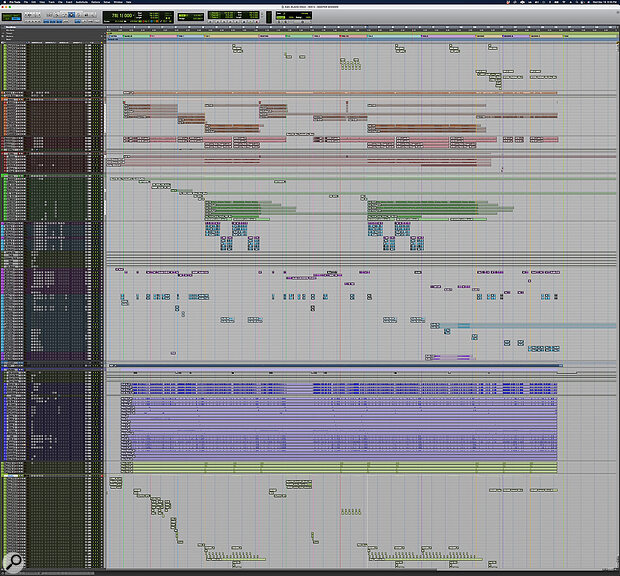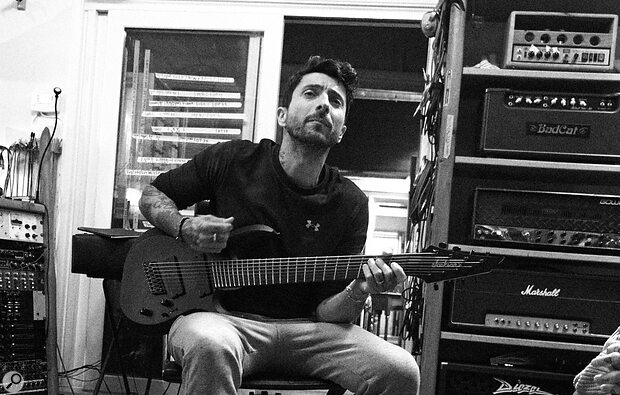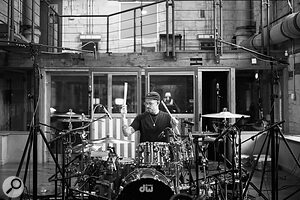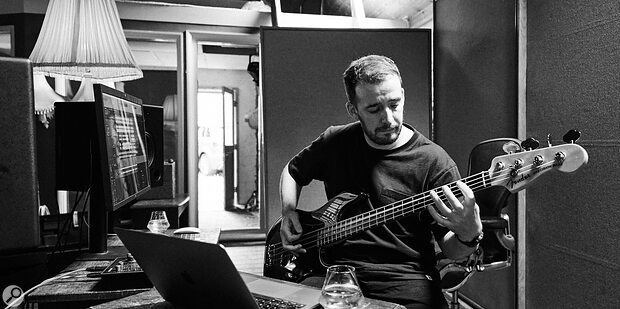 Jordan Fish at Middle Farm Studios.Photo: Ed Mason
Jordan Fish at Middle Farm Studios.Photo: Ed Mason
Metalcore presents unique production challenges — and few are better placed to meet them than genre veteran Jordan Fish.
As co-songwriter and co-producer with Bring Me The Horizon, Jordan Fish has had a defining role in their success. Late in 2023, he left the band to pursue a production career, since when he’s made successful records with Poppy, House Of Protection, Dutch singer S10 and metalcore band Architects. Fish co-wrote and produced almost the whole of Architects’ 11th album, The Sky, The Earth & All Between, which went to number two on the UK album charts.
Play It Safe
 The Sky, The Earth & All Between is Architects’ 11th album.Although he works in genres where virtuosity is highly valued, Jordan Fish cheerfully admits that his own instrumental skills are limited. He chuckles that his impressive BMTH live keyboard rig had “a lot of buttons for not much talent! I can’t play keyboards to save my life. My first instrument is probably guitar, and I used to play trumpet when I was younger, which also gave me some music theory knowledge. Playing a little bit of guitar is helpful for rock music, and I have an understanding of how a drummer plays, which is helpful for programming.
The Sky, The Earth & All Between is Architects’ 11th album.Although he works in genres where virtuosity is highly valued, Jordan Fish cheerfully admits that his own instrumental skills are limited. He chuckles that his impressive BMTH live keyboard rig had “a lot of buttons for not much talent! I can’t play keyboards to save my life. My first instrument is probably guitar, and I used to play trumpet when I was younger, which also gave me some music theory knowledge. Playing a little bit of guitar is helpful for rock music, and I have an understanding of how a drummer plays, which is helpful for programming.
“It’s not that I have a problem with virtuoso players. I would love to be one, but I’m not. I respect anyone who is amazing at their instrument. I often tell myself that one day I’m going to really learn how to play the piano properly, but it’s probably not going to happen because I’m working all the time. My musical mind is my strength, more than my ability to play. Any time I should have dedicated to learning to master an instrument, I spent trying to make things. Producing and writing is a natural fit for me, so I would say that my first instrument is the laptop.
“As a teenager I started messing around with production on a computer using Nuendo, and then I went to the School of Audio Engineering in London for a year, where I learned Pro Tools. After that I worked in a studio called Phoenix Sound, at Pinewood Studios in London, where they were also using Pro Tools.
“I worked there for a couple of years, starting in reception, making tea, and earning the minimum wage and all that stuff. They let me use the studio in the evenings and at night, and eventually they let me run sessions. So I was very much on the trajectory of being a recording studio engineer. Over time, I was working with bands and I would make small suggestions or I would add stuff. That moved me into production. Because I was into engineering, I was into the more techy side of things, and I guess that’s why I ended up being a synth person, but it’s not really where I came from. I was more an engineer going into production.”
Soft Start
Fish spent almost 12 years with Bring Me The Horizon, taking the band’s sound more into electronic music territory, and to some degree bluffing his parts live with a live setup based around Apple’s MainStage software and Arturia’s KeyLab MkII and Beatstep hardware. At the end of 2023, while still in BMTH, Fish connected with Architects, initially in an informal way.
“The first song I had an involvement in was ‘Seeing Red’. Dan [Searle, drummer] and Sam [Carter, singer] from the band sent me the song and I gave some feedback via text, and they took it on board. We also went back and forth a little bit over the vocal melody, just over voice memo with me singing some vocal parts, and they then sent me back another version. I never opened my laptop. It was just a mate giving his opinion, but technically speaking it was to some extent production and writing.
 Like Jordan Fish’s own band Bring Me The Horizon, Architects have painstakingly built a huge worldwide fanbase over a lengthy career.
Like Jordan Fish’s own band Bring Me The Horizon, Architects have painstakingly built a huge worldwide fanbase over a lengthy career.
“The song came out really well, and in the beginning of 2024, Sam, Dan and I spent a few days together for writing sessions at the studio of the band Royal Blood in Brighton. They had a bunch of demos, and I had some ideas. Each song was different. Sometimes we’d start from nothing. Sometimes Dan had a riff that I’d pull into my computer. I’d say, ‘Give me half an hour, and I’ll try and find a way to make it a song.’ Maybe I changed the tempo, or added some sounds, or I was tweaking the riff to see if I could make it better. I was just trying to catch a vibe to be able to say, ‘OK, here’s what I’m hearing for this.’
“If we all liked where it was going, we’d work out whether what we had was a post-chorus riff or a chorus, and then build on it and create some other sections. Usually the first few hours were focused on trying to get some music that we were all excited by, and then melodies came pretty quickly. I would get onto top-lining pretty early on. I top-line quite a lot, if it’s something that the artist or band wants. Dan and Sam were open to it, so it was a matter of passing around the mic, and if anyone had an idea, they’d sing it, and then someone else might develop that. The melody writing was very collaborative. At this point the musical parts were all programmed, even though I sometimes added some guitars.”
One DAW Opens...
While Fish works in Pro Tools, Sam Carter and Dan Searle were in Logic. “I don’t mind the different DAWs situation,” comments Fish. “We swapped files using AirDrop and hard drives. It feels a bit messy, but I actually like getting a bunch of audio files. It makes working in Pro Tools like having a collage, which is more interesting for me. I’m ripping through the audio files and find the things that work. Sometimes I change the sounds, or add programming, synths or atmospheres. I’d be doing this in front of Dan and Sam, and they’d be guiding.
“I know people say that Pro Tools is less suited for MIDI, but it’s all I’ve ever known. For me it’s always been OK. I’m so familiar with Pro Tools, it feels like my safe place. The way I work in Pro Tools is completely wrong on every front, in any case. For example, I don’t know any shortcuts. I’ve made full albums on my laptop with a trackpad. When I first went to LA, my friend [mixer] Zakk Cervini said ‘You’re going to have to stop working on the trackpad. You need a mouse and a keyboard because it’s insane.’ Switching has sped up my process a little bit, but other than that I dare not change my process much because for some reason it works.
“A lot of people use samplers and stuff, and they manipulate audio within plug-ins. I don’t really do that. I manipulate audio on the timeline. My timeline looks like an absolute mess, because I constantly chop and paste things. Let’s say I’m doing some pitched vocal type thing. A lot of people would map it to MIDI and they would draw in MIDI notes. But I will take the audio and grab [AudioSuite plug-in] Pitch Shift and do everything on the timeline. It’s a messy way of working. The same with beats. A lot of people use [NI] Battery, or some sampler type thing. But I will paste one-shots in the timeline. I do use MIDI, but prefer manipulating audio. I just feel a bit more at home there. So my sessions consist of manipulated audio combined with MIDI.”
 This composite screen capture shows the Pro Tools session for ‘Blackhole’, the final track recorded for the album.
This composite screen capture shows the Pro Tools session for ‘Blackhole’, the final track recorded for the album.
Making Notes
The MIDI data that Fish does generate is rarely played in live. “I have a very small MIDI keyboard, but honestly, I rarely use it. I’m usually drawing notes in with a mouse. I’ve always been a soft synths guy, and keyboards are for live. Before I had the Arturia live setup, I had Nord and Akai keyboards. There used to be quite a bit of piano in the earlier stuff I did with Bring Me, for which I used the Nord. But it was really complicated. The software was primitive. It used to take forever to sample things in there. So eventually one of my techs suggested we run everything from a laptop, to which we connected the keyboards via MIDI.
“In the studio, my sound sources are pretty basic. I use Xfer Serum often. I’ve saved many good presets and sounds over the years, so my Serum’s pretty loaded up with stuff I like for starting points. I usually start with Serum unless I am going for something a bit more sample-based. I also use Spectrasonics Omnisphere a lot, actually more than Native Instruments, because I like not having to make decisions about the sounds up front. When I open Kontakt, I immediately have to make a decision as to what library to load. Whereas when I open Omnisphere, all the libraries are there. Usually I start from a preset, because I like to get an idea down quickly, and also, I enjoy having the random element of not really knowing what I’m going to get sonically.
“I still use a lot of pianos, particularly Noire, which is a Kontakt piano. It’s unusual because it has noise and stuff built into it, like weird hammer and vinyl sounds. It’s a bit more characterful than a straight piano, which I quite enjoy. When I’m programming real drums, I use GetGood Drums. I also have plug-ins for bass and guitar, when I don’t have access to a real guitar. If I’m trying to write a riff on a plane, I can just use MIDI. That’s basically it. Nothing crazy. I have a lot of software that I forget about for a few months and then I’ll come back to it. I go through cycles. There are just too many options. Realistically, I could probably do everything with just Serum and Omnisphere.”
On The Farm
After the sessions at the Royal Blood studio, work on The Sky, The Earth & All Between continued at several other studios. “We wrote pretty much the entire album during the Royal Blood sessions. We also demo’ed vocals there, using a Shure SM7, without being bothered about the fidelity, and we ended up redoing the vocals again later. The band went to Real World studios to record the drums. I wasn’t there because I was doing another record. The MIDI drums were all written, and Dan replaced them with real drums.
“After that we spent a spent a couple of weeks at Middle Farm Studios in Devon, where we mostly finished the album. We also wrote one more song there, called ‘Blackhole’, which was the last piece of the record that we felt we needed, and that ended up being one of the singles. We split into two groups at Middle Farm. Engineer Chris Clancy worked with Adam [Christianson] and Alex [Dean] to record all the guitar and bass parts, and I went in the studio B with Sam to retrack all the vocals. Sometimes we’d go over to check how they were getting on with the guitars and bass. It was like a boot camp situation to finish their record, which I like.
“The bass and guitar followed the blueprints of the demos. We kept some of the rough guitars from the demos, but Adam replayed most. There were some creative elements in there, but at that point the songs were written and the arrangements mapped out. It was mostly a matter of how to play the parts and with what tone, and how to layer them. I left it to Adam and the engineer to work out which guitar to use. The guitars were recorded using a Neural Amp Modeler, and they would choose their amps. The bass was tracked using a SamsAmp Pedal DI. They gave me the guitar and bass parts frozen, as audio. I could have unfrozen them and dug out the DI recordings if I wanted to, but I never did.
 Final guitar and bass tracks for the album were laid down at Middle Farm.
Final guitar and bass tracks for the album were laid down at Middle Farm.
“The engineer at Middle Farm, Pete Miles, set up me up with a vocal chain, and Sam and I took it from there. Pete was the first person I recorded with when I was 16. I trust him completely. The signal chain would have been a Neve pre, and a [Empirical Labs] Distressor on the way in, just like at my home studio, where my signal chain is a Neve 1073, a Distressor, and a Warm Audio WA-800, which is a Sony C800 clone. I can’t recall what mic we used at Middle Farm, but it will have been a condenser.”
Taking Inspiration
 Architects drummer Dan Searle goes for a take in the Wood Room at Real World Studios.During the entire process of writing, arranging and recording, Fish kept a keen ear on the overall musical vision, the performances and the sonics, constantly rough mixing as the project progressed. In so doing he was drawing on his previous production experiences, and also his biggest inspiration, Nigel Godrich’s productions of Radiohead and Thom Yorke. “It’s a completely different genre, but Radiohead is a reference that comes up for me every time I make a song. I think of something they did at some point, all the time. Nigel Godrich’s productions are super, super influential. The first time I heard Kid A and Amnesiac, I loved the almost surreal, super-clean, dry sound. It didn’t sound like it was in a room, it existed just in your brain. I really love that sound. I also adore Thom Yorke’s solo album, The Eraser. Obviously most of my work is in much heavier music. Radiohead is like going to the theatre, whereas heavy music is like going to a theme park. You’re going to be blasted out of the cannon and fly! The emotions are a lot less subtle, but it’s no less fun.
Architects drummer Dan Searle goes for a take in the Wood Room at Real World Studios.During the entire process of writing, arranging and recording, Fish kept a keen ear on the overall musical vision, the performances and the sonics, constantly rough mixing as the project progressed. In so doing he was drawing on his previous production experiences, and also his biggest inspiration, Nigel Godrich’s productions of Radiohead and Thom Yorke. “It’s a completely different genre, but Radiohead is a reference that comes up for me every time I make a song. I think of something they did at some point, all the time. Nigel Godrich’s productions are super, super influential. The first time I heard Kid A and Amnesiac, I loved the almost surreal, super-clean, dry sound. It didn’t sound like it was in a room, it existed just in your brain. I really love that sound. I also adore Thom Yorke’s solo album, The Eraser. Obviously most of my work is in much heavier music. Radiohead is like going to the theatre, whereas heavy music is like going to a theme park. You’re going to be blasted out of the cannon and fly! The emotions are a lot less subtle, but it’s no less fun.
“When working on the Architects album, I would rough mix at the end of every day. We had roughs right from day one. You can call the demos we worked on together rough mixes, and they just grew organically as the whole thing came together. They were always evolving and changing. I tried to keep them sounding as good as possible. The roughs sound pretty decent. I’m tweaking as I go, but unless we get to the end, I’m not really using any automation, because there may still be structural changes to the arrangements.”
Switch It Up
A characteristic feature of metalcore is extreme changes between gentle, almost pastoral instrumental sections and full-on metal, accompanied by a switch from singing to screaming. Were these dramatic shifts a challenge to handle?
“Definitely in terms of threading together really heavy elements and clean singing, there are hurdles: how do you get from an angry, intense place to a section with clean singing in a way that doesn’t feel jarring? How do you make all emotions feel coherent when they’re so different? Usually with this music, if the choruses are clean, they end up being quite epic. There’s so much aggression in the louder bits, that the only other feeling that can match this is intense emotion. ‘Blackhole’ is a good example of a song that’s very aggressive, while the [cleanly sung] chorus is very emotional and desperate.
Jordan Fish: With electronic music, a lot of the energy is super low. But with rock and metal, the energy generally is in the midrange, and mostly from the guitars.
“Also, with a metal band, with the guitars and the drums being a real drum kit, there’s so much midrange energy that something has to give. In the pursuit of loudness, the real low sub usually gets compromised somewhat. It’s a matter of space. It’s just a different style of music. With electronic music, a lot of the energy is super low. But with rock and metal, the energy generally is in the midrange, and mostly from the guitars.
“We wrapped up the album in June of 2024, at Middle Farm. I also did some work at my studio, where I have PMC6 monitors with a Focal sub, and a Universal Audio Apollo x4 interface. Once we had finished tracking and I had finished my work, I delivered the album to Zakk Cervini, who mixes most of what I produce. I actually had to be in LA, so I sat in with him at his home studio during his mixes, giving my two pence of opinions to help the project get over the line.
“Zakk used my roughs as a reference. He usually does not rip everything I have done out, but he’s also not chasing it. He’s worked with Architects before, so he knows what they are going for. Because he also works in Pro Tools, it’s easy for him to pick up where I left off, and if he likes what I have done he keeps it, but he’s also not afraid to change things. Zakk always laughs at what I have done, because I do terrible things, like using a [stock Pro Tools 1176 emulation] BF76 on the mix bus. I’m like, ‘It sounds good!’ but he always replaces it. I like the BF76. It sounds nothing like an 1176, which is quite present and aggressive, whereas the BF76 is like cling film. In general I’m accustomed to the Pro Tools plug-ins, and also use the Pro Tools EQ a lot.
“Zakk has a great ear, and I trust what he does. Sometimes when mixing, perhaps in one in 10 cases, things gets lost for some reason, or a section’s just not hitting the same, or not doing the same thing, and you have to try and work out why. For example, there was a section where there was a loud and resonant fuzzy guitar, which was technically wrong, but once it got fixed and mixed in, it was no longer doing the same thing. We’d lost something. So there was a bit of that. But I enjoy leaving some room for someone else to do a better job than me. I don’t want to fight to make my stuff sound amazing, knowing that I’m going to get the extra 20 percent from someone mixing who actually knows what they’re doing.”
Hot & Dry
“I am not an audiophile and am normally not too worried about fidelity,” insists Jordan Fish. “Whatever works, works. But I hate the sound of dynamic mics for vocals.
“I like condensers for the high‑end detail, especially when the mic has been massively saturated. I like the really bright, fizzy, white noise element that you can get out of a vocal. I use the same mic for clean vocals and for the screaming vocals, but we tend to record those during separate sessions. Generally, we go for the cleaner stuff first, because the screaming is fatiguing, for everyone in different ways. And yes, it’s full volume screaming. Sam [Carter] screams as loud as he possibly can.
“It depends on the mic, but I usually don’t use the pad. Honestly, a little bit of preamp distortion is OK, as long as it’s not crazy. The screaming is treated like you would expect, with lots of compression and saturation. In the box I’ll probably use a UAD 1176, and two more compressors. I don’t tend do use reverbs. I prefer delays. I’m not a fan of a super wet vocal, unless I’m going for an effect or specifically a wet section. I’ll certainly keep all my screams completely dry. Reverb gives me the ick. I don’t mind reverb when there’s loads of stuff going on and it’s just sitting in. But when it’s an open verse and you can hear a medium length reverb, it feels synthetic to me.”

